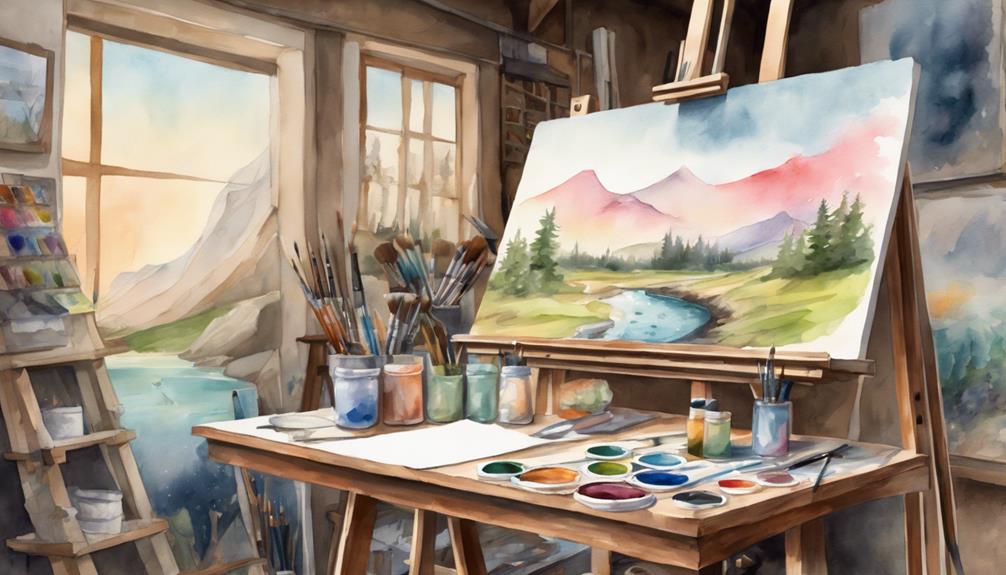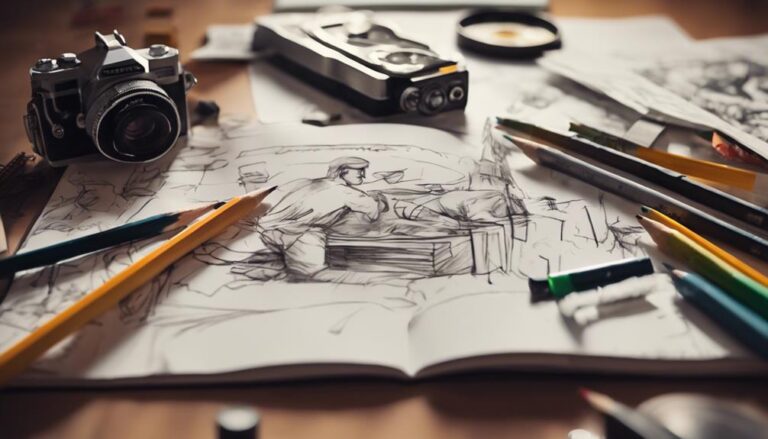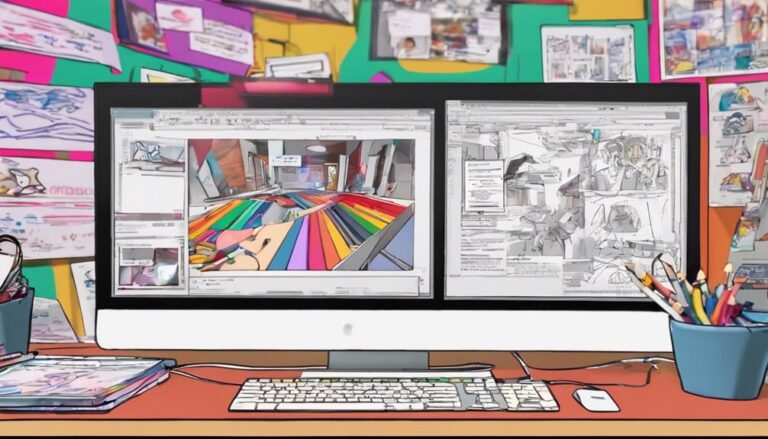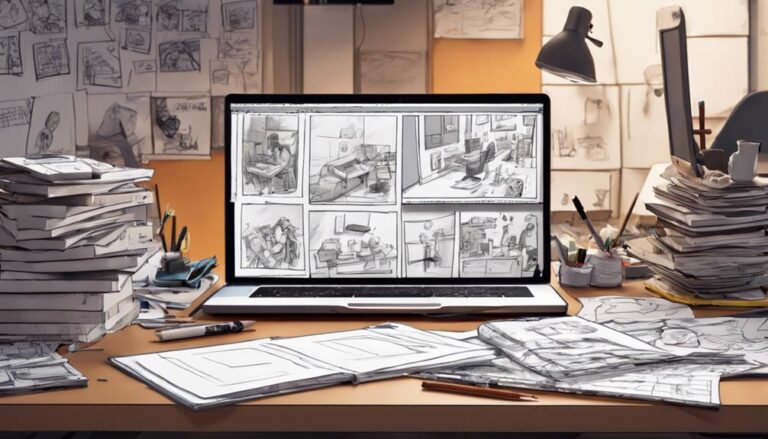5 Best Hand-Painted Animation Backgrounds Process
You're about to explore the 5 best hand-painted animation backgrounds processes that'll transport your audience into vivid worlds. Starting with traditional painting techniques that require mastering color theory, composition, and light and shadow. You'll learn to apply delicate, feathery textures and bold, expressive marks using specific brush strokes and canvas textures. Techniques like watercolor, hand-drawn design, and mixed media will also be explored. The interplay between different media and tools will be revealed, taking you through a journey of creating ethereal environments, refining textures, and adding depth and interest to your backgrounds, which is just the beginning of unraveling the process.
Key Takeaways
- Mastering traditional painting techniques is crucial for hand-painted animation backgrounds, encompassing color theory, composition, and light and shadow.
- Watercolor techniques can unlock ethereal, dreamlike environments by experimenting with transparency, layering, and blending.
- Combining traditional media with digital tools offers a unique approach to hand-painted animation backgrounds, allowing for refinement and manipulation.
- Developing a color script ensures a cohesive color palette, while creating a style guide outlines visual elements for consistency.
- Experimenting with different textures and materials, such as canvas or paper, adds depth and interest to hand-painted animation backgrounds.
Traditional Painting Techniques
As you delve into the world of hand-painted animation backgrounds, mastering traditional painting techniques is crucial.
You'll need to develop a deep understanding of color theory, composition, and the subtleties of light and shadow. To achieve the desired effect, you'll require a range of brush strokes, from delicate, feathery textures to bold, expressive marks. Practice using a variety of brushes, experimenting with different styles to capture the unique character of your scene.
Pay close attention to canvas textures, as they can greatly impact the final result.
A rough, linen-weave canvas can add a tactile quality to your work, while a smooth, cotton canvas can produce a more refined, detailed finish. Consider the specific requirements of your project and choose a canvas that complements your style.
When applying paint, use bold, confident brush strokes to block in large areas of color, then gradually build up layers of detail and texture.
Watercolor Background Creation
Within the realm of hand-painted animation backgrounds, mastering watercolor techniques can unlock a world of ethereal, dreamlike environments.
To achieve this, you'll need to experiment with various watercolor nuances, such as transparency, layering, and blending. Begin by selecting the right paper – look for cold-pressed or rough textures, as these will enhance the organic feel of your watercolors.
When applying paint, consider the absorbency of the paper and the viscosity of the watercolors. This interplay will influence the final result, adding depth and visual interest to your background.
As you work, pay attention to the way the watercolors interact with the paper textures. Notice how the pigments pool and spread, creating subtle, unique patterns.
To maintain control, use a limited palette and experiment with glazing techniques. By layering multiple transparent washes, you can achieve rich, luminous colors that seem to glow from within.
Don't be afraid to let the watercolors bleed and merge – this will add a sense of spontaneity and life to your background.
Hand-Drawn Background Design
Building upon the dreamlike quality of watercolor backgrounds, hand-drawn designs offer a distinctively tactile approach to animation background creation.
As you develop your hand-drawn background design, consider the unique textures and organic feel that this technique can bring to your animation.
When creating hand-drawn backgrounds, you'll want to ensure consistency throughout your design.
To achieve this, consider the following steps:
- Develop a style guide: Create a comprehensive guide that outlines the visual elements of your background design, including color palettes, textures, and composition.
- Create a color script: Plan out the color progression of your background design to ensure a cohesive look and feel.
- Use reference images: Gather reference images to inspire and inform your background design, ensuring accuracy and authenticity.
- Experiment with media: Try out different drawing tools and media to achieve the desired texture and look for your background design.
Mixed Media Process Steps
Combining traditional media with digital tools, a mixed media approach to hand-painted animation backgrounds offers an exciting way to push the boundaries of your art.
You can experiment with various materials and techniques to achieve unique textures and effects. Start by creating a base layer using traditional media such as watercolor, gouache, or ink.
This layer will provide the foundation for your background and can be manipulated digitally later.
Next, explore different textures and materials to add depth and interest to your background.
Try incorporating fabric, paper, or found objects to create intricate patterns and designs. You can also use natural materials like leaves, twigs, or flowers to add organic textures.
Experiment with different painting techniques, such as layering, glazing, or scraffito, to achieve unique visual effects.
As you work, document your process and experiment with scanning or photographing your artwork at different stages.
This will allow you to refine your design and make adjustments before finalizing your background.
Digital Painting Enhancements
Once you've created a rich, textured base layer in traditional media, you can take your hand-painted animation backgrounds to the next level by incorporating digital painting enhancements.
This process allows you to refine and perfect your artwork, making it more engaging and immersive for your audience.
With digital painting software, you can:
1. Enhance brush textures: Add subtle nuances to your brushstrokes, creating a more realistic and organic feel.
You can also experiment with custom brush textures to achieve unique effects.
2. Develop color scripts: Create a cohesive color palette that guides the mood and atmosphere of your animation.
This ensures consistency throughout your backgrounds and enhances the overall visual storytelling.
3. Add atmospheric effects: Incorporate subtle lighting, fog, or mist to create depth and dimension in your backgrounds.
These effects can greatly enhance the emotional impact of your animation.
4. Make precise edits: Easily correct mistakes or make adjustments to your composition, color, or texture with the precision of digital tools.
This flexibility allows you to refine your artwork without compromising the original hand-painted feel.
Frequently Asked Questions
What Software Is Used for Digital Painting Enhancements?
You're likely using software like Adobe Photoshop or Corel Painter for digital painting enhancements, utilizing digital brushes that mimic traditional media and pairing them with painting tablets for a more hands-on, expressive experience.
How to Fix Mistakes in Hand-Painted Animation Backgrounds?
When fixing mistakes, you'll prevent future errors by applying painting strategies like layering, testing colors, and using a limited palette, allowing you to correct and perfect each brushstroke with precision and patience.
What Materials Are Needed for Mixed Media Process?
When exploring mixed media, you'll need an eclectic art supply, including paints, inks, paper, and textured materials, to unlock creative freedom and bring your unique vision to life through layered, dimensional artworks.
Can Hand-Painted Backgrounds Be Used in 3D Animation?
You can seamlessly integrate hand-painted backgrounds into 3D animation by achieving visual harmony through complementary color palettes, matching textures, and clever 3D integration techniques, creating a rich, immersive atmosphere that elevates your animation.
Are Hand-Painted Backgrounds Still Used in Modern Films?
You'll notice hand-painted backgrounds still being used in modern films, often evoking film nostalgia and artistic merit, as seen in works like 'Spirited Away' and 'The Princess and the Frog', where tradition meets innovative storytelling.
Conclusion
By mastering the art of hand-painted animation backgrounds, you'll elevate your storytelling and transport audiences to unique worlds. You've explored traditional painting techniques, delicate watercolor creations, hand-drawn designs, and mixed media processes. Digital enhancements have also allowed you to refine and perfect your work. With these skills, you'll create captivating environments that draw viewers in and bring your animated tales to life in breathtaking, one-of-a-kind ways.







